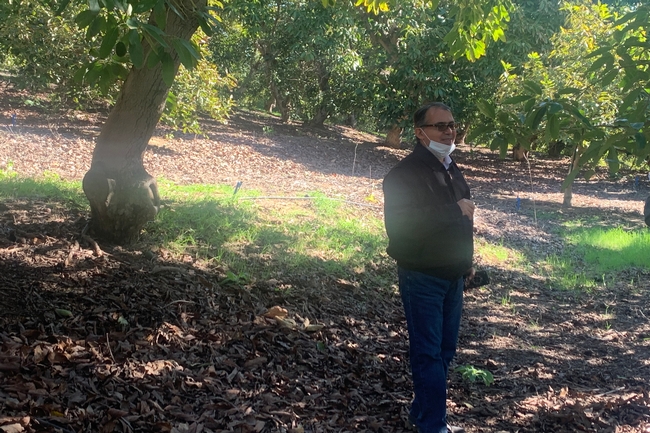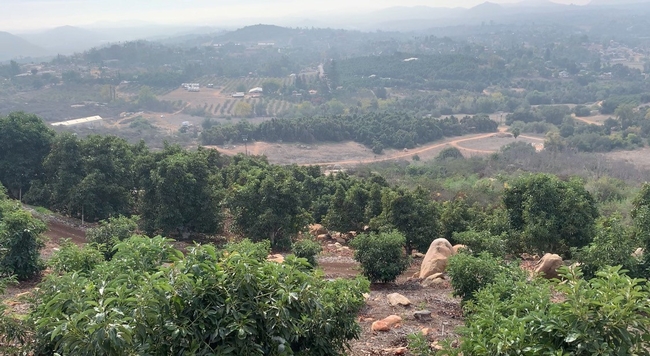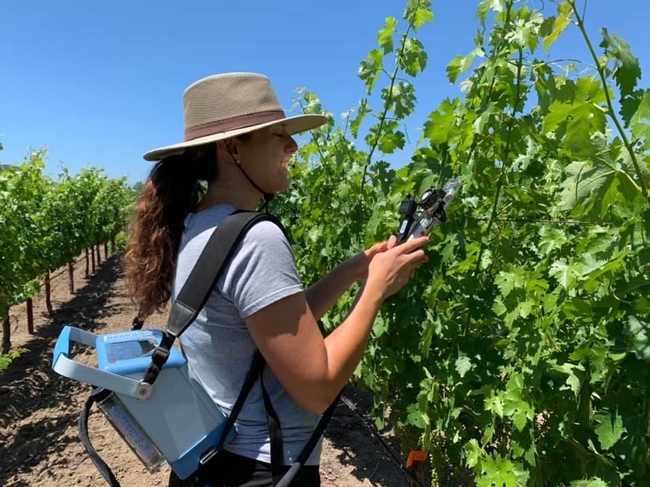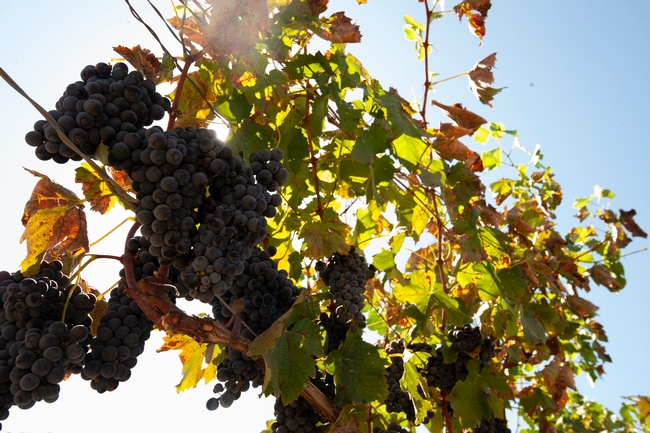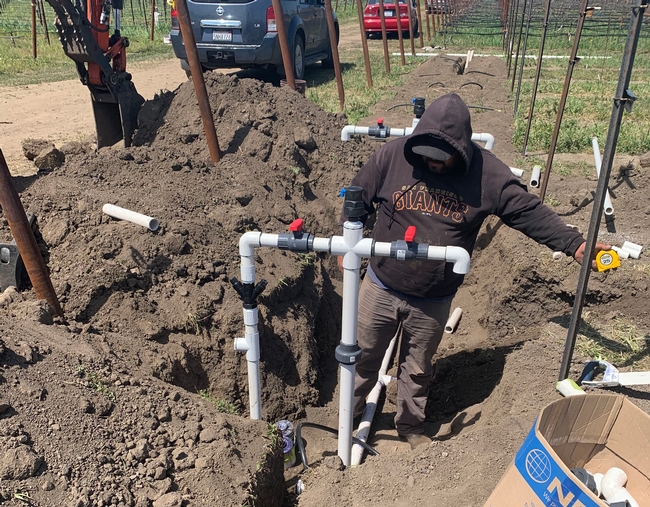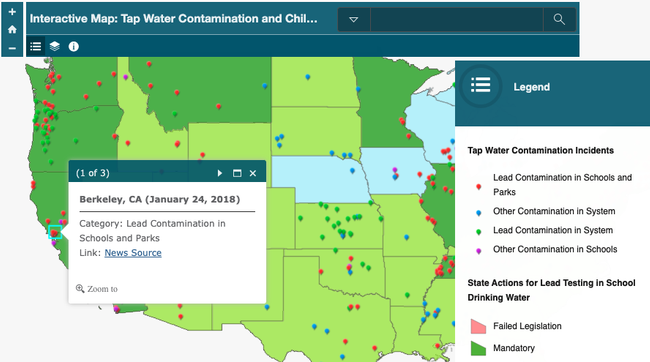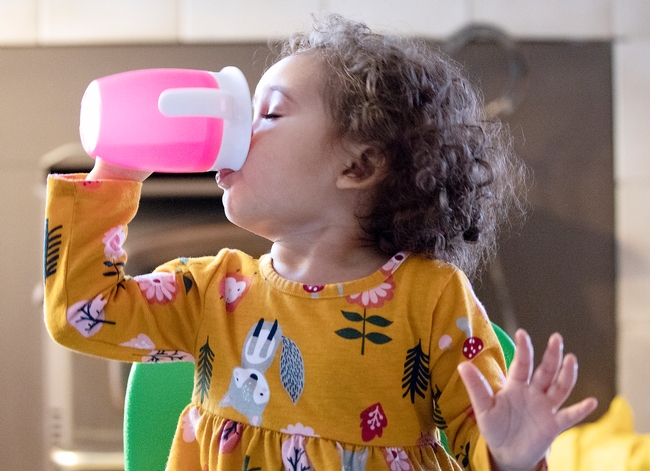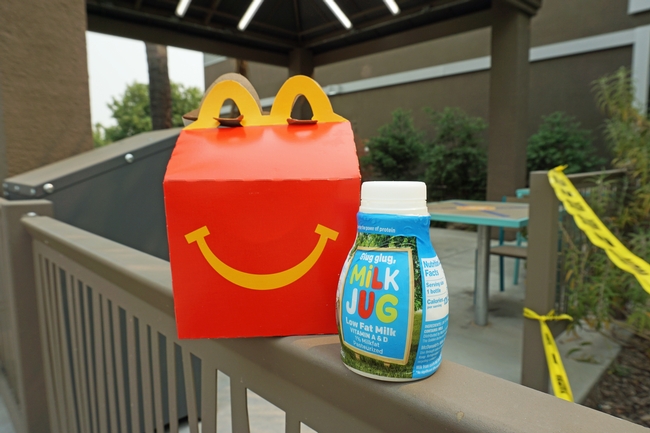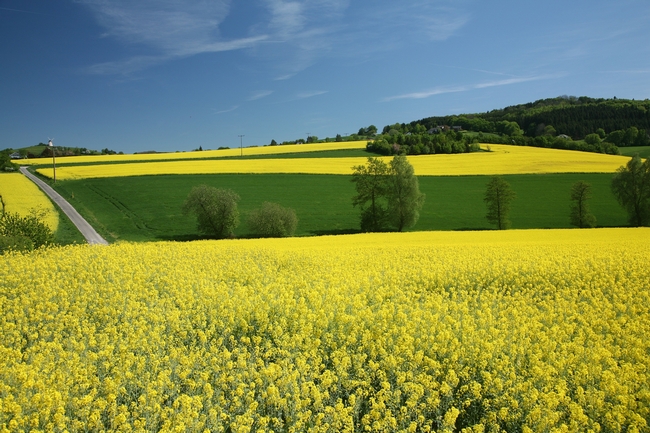Posts Tagged: water
Avocado growers to get irrigation tools, strategies from UC ANR’s Montazar
CDFA grant supports research to optimize water use for iconic California crop
California growers, who account for more than 90% of avocado production in the U.S., will soon be getting some help in weathering the extreme fluctuations of climate change.
Ali Montazar, a University of California Cooperative Extension irrigation and water management advisor, recently received a grant to develop tools and strategies that optimize growers' irrigation practices across Southern California – the state's avocado belt. California avocados are valued at more than $411 million, according to the National Agricultural Statistics Service.
“This region faces uncertain water supplies, mandatory reductions of water use, and the rising cost of water – while efficient use of irrigation water is one of the highest conservation priorities,” Montazar said. “Water is the most critically important input to avocado production.”
At the California Avocado Commission's suggestion, Orange County was added to the study to better capture the range of climates and cropping systems across the region, Montazar said.
He hopes to develop “crop coefficients” that avocado growers can use to determine the optimal irrigation for their crop based on a host of factors: soil type and salinity, canopy features, row orientation, slopes, soil and water management practices, and more.
“Growers are unclear on how much water the crop actually needs under those conditions,” Montazar said.
He will incorporate data from the actual water use in the experimental orchards – including information from the newest soil moisture and canopy temperature sensors – to help ensure growers do not under- or overwater their crops. Overirrigating contributes to a devastating disease, avocado root rot, caused by the plant pathogen Phytophthora cinnamomi.
Another component of the grant supports outreach in disseminating these resources and best practices to the broader agricultural community.
“Developing and adopting these tools and information may have a significant impact on water quality and quantity issues and bolster the economic sustainability of avocado production not only in the well-established production region of Southern California, but also in Kern and Tulare counties where new avocado plantings are growing,” Montazar said.
Preliminary findings and recommendations are expected at the end of 2022.
Coastal grape growers can use less water during drought
Study finds using less doesn't compromise quality
California grape growers in coastal areas can use less water during times of drought and cut irrigation levels without affecting crop yields or quality, according to a new study out of the University of California, Davis.
The findings, published today (Sept. 1) in the journal Frontiers in Plant Science, show that vineyards can use 50% of the irrigation water normally used by grape crops without compromising flavor, color and sugar content.
It sheds new light on how vineyards can mitigate drought effects at a time when California is experiencing a severe water shortage and facing more extreme weather brought on by climate change, according to lead author Kaan Kurtural, professor of viticulture and enology and an extension specialist at UC Davis.
“It is a significant finding,” Kurtural said. “We don't necessarily have to increase the amount of water supplied to grape vines.”
Growers will also be able to use this information to plan for the next growing season. “Everybody's worried about what's going to happen next year,” he said.
Kurtural and others from his lab studied irrigation and cabernet sauvignon grape quality at a research vineyard in Napa Valley over two growing seasons, a rainy one in 2019 and a hyper-arid one in 2020.
They focused on crop evapotranspiration, which was the amount of water lost to the atmosphere from the vineyard system based on canopy size. The weekly tests used irrigation to replace 25%, 50% and 100% of what had been lost by the crop to evapotranspiration.
Researchers found that replacing 50% of the water was the most beneficial in maintaining the grape's flavor profile and yield. The level of symbiotic arbuscular mycorrhizal fungi, which help grapevines overcome stresses such as water deficits, was also not compromised. And the water used to dilute nitrogen application was also reduced, making the process more environmentally friendly.
The water footprint for growing grapes also decreased. For both the 25% and 50% replacement levels, water use efficiency increased between 18.6% and 29.2% in the 2019 growing season and by 29.2% and 42.9% in the following dry year.
While focused on cabernet sauvignon, most red grapes will respond similarly, he said.
“In the end, drought is not coming for wine,” Kurtural said. “There doesn't need to be a tremendous amount of water for grapes. If you over irrigate in times like these, you're just going to ruin quality for little gain.”
Members of Kurtural's lab — Nazareth Torres, Runze Yu, Johann Martinez-Lüscher and Evmorefia Kostaki — are also credited as authors.
University of California Agriculture and Natural Resources provided partial funding.
For more information, contact:
- Kaan Kurtural, Viticulture and Enology, skkurtural@ucdavis.edu
- Amy Quinton, UC Davis News and Media Relations, amquinton@ucdavis.edu
- Emily C. Dooley, College of Agricultural and Environmental Sciences, ecdooley@ucdavis.edu
Interactive map flags locations of tap water contamination
Drinking water safety, especially for children, has become an issue of heightened concern since the water crisis in Flint, Michigan, in 2014.
The National Drinking Water Alliance map has recently been updated to add over 235 new points linking to news reports of tap water contamination, with nearly half of the incidents emerging since 2019.
“We created the map to help community members, advocates and decision-makers visualize the tap water contamination landscape, particularly for incidents of lead that exceed state action levels,” said Christina Hecht, UC Nutrition Policy Institute senior policy advisor and National Drinking Water Alliance coordinator.
Residents can zoom in on their state to check for contamination incidents that were reported in the news. Red pins indicate lead contamination in schools and parks. Clicking on a pin on the map produces a pop-up box containing the name of the town, date and link to the news story.
“Although most tap water is safe for drinking, the number of dots on the map show that there are times and places where tap water is not safe,” Hecht said. “The only way to know if tap water has elevated lead is by testing through an accredited lab.”
The interactive map was created by the Nutrition Policy Institute and Informatics and Geographic Information System at the University of California Agriculture and Natural Resources. The map only includes tap water contamination with lead and contaminants regulated by the U.S. Environmental Protection Agency. For example, reports of perfluoroalkyl substances, or PFAS, contaminating drinking water are not included because PFAS are not regulated by the EPA.
Although a few states now maintain some type of online database of results from school or childcare tests for lead in tap water, to date, there is no national database of lead exceedances in school or childcare drinking water.
The National Drinking Water Alliance map includes information on state policies and programs to test for lead in school drinking water. Almost one-third of U.S. states have enacted legislation providing policy to test for lead in drinking water in schools and, in some cases, in child-care centers. California tests for lead in drinking water at all public K-12 schools and posts the results online. Policies for mandatory testing have recently passed in Oregon and Vermont. New legislation has been proposed in Wisconsin, Iowa, Nebraska and Connecticut. Voluntary programs are now present in every state, funded by nationwide federal grants supporting testing in child-care facilities and schools.
More information on each state's actions can be found on the interactive map at www.drinkingwateralliance.org/new-map, which was updated by Nutrition Policy Institute intern Laurel Denyer, a recent UC Davis graduate.
For more information about drinking water safety, and to propose additions to the map, please contact the NDWA at DWAalliance@ucanr.edu.
New policies can inspire families to provide healthy beverages to children
At fast food and sit-down restaurants across California, kids' meals come with water or milk automatically. At least, that should be the case since state law requires restaurants to offer the healthy beverages by default to reduce the amount of sugary beverages served to children.
California Senate Bill 1192, authored by Sen. Bill Monning (D-San Luis Obispo), went into effect Jan. 6, 2019, but research by the UC Nutrition Policy Institute (NPI) has found that implementation has not been universal and more can be done. The results, along with results from a similar study in Wilmington, Del., were published Aug. 20 on HealthyEatingResearch.org.
Before the law, 10% of menu boards observed by the researchers in California listed only the healthy beverages. Data collected after the law went into effect showed 66% of menu boards list the healthy default beverages. The researchers also collected data on the proportion of cashiers who verbally offered only healthy beverages with kids' meals when orders were placed. This happened only 5% of the time before the law was enacted, and dropped to 1% after.
“Parents look at menu boards and kids look at menu boards, but it is likely that what the cashier says also influences which drink they choose,” said Lorrene Ritchie, NPI director and UC Cooperative Extension nutrition specialist. Ritchie was the lead researcher on the California portion of the study. “In our data collection, we would order a kids' meal and wait for them to offer a drink. But mostly they said, ‘What drink do you want?' instead of ‘Do you want water or milk with that?'”
The law doesn't specify whether the cashier must offer the default beverages, but the spirit of the law suggests they should, as it would likely have a greater impact on the selections that children and parents make, Ritchie said.
According to Gail Woodward-Lopez, an NPI researcher and co-investigator on the study, most restaurant managers expressed support for the legislation, but didn't know much about it.
“NPI in partnership with the California Department of Public Health is working with some local health departments to provide training and materials to help restaurants comply with the letter and spirit of the law,” Woodward-Lopez said. “Our next step is to measure whether this health department support is effective.”
The dire need to direct children away from sugary sodas is clear. Empty calories from soda and other sugar-sweetened beverages is the No. 1 cause of obesity in children, Ritchie said. Obese children are at least twice as likely as non-obese children to become obese adults. Obese children and adults are at greater risk for Type 2 diabetes, heart disease, stroke, high blood pressure, high cholesterol, certain cancers, asthma, low self-esteem, depression and other diseases. The Centers for Disease Control and Prevention names obesity as one of the conditions that increase risk of severe illness from COVID-19.
Many open questions remain, such as how drinks are portrayed on drive-thru signs and offered by drive-thru order takers. The COVID-19 pandemic has also altered the way Americans purchase food, with increased online ordering, delivery and drive-thru usage. In-store kiosk ordering is also growing in popularity.
“The role of default beverage policies in this context is important and not well understood,” Woodward-Lopez said.
Woodward-Lopez and Ritchie are working with colleagues around California and across the country to design follow-up studies of newer food technologies and beverage policies being passed elsewhere, to determine how government policies can protect children's health by steering them toward healthy beverage consumption.
The newly published research was funded by the Robert Wood Johnson Foundation and by the California Department of Public Health with funding from the United States Department of Agriculture.
Trends we're watching in 2018: experts weigh in on water, GM, science communication and more
As we settle into 2018, it's natural to wonder what the New Year may bring. There have been dozens of "trend pieces" discussing what's in store. In this wrap, we consider possible 2018 trends in water, the GM debate, science communication, and food and nutrition.
Water
After one of the driest Decembers on record, many Californians continue to worry about water supply. I turned to UC ANR water expert Faith Kearns. Faith is a scientist and communicator at the California Institute for Water Resources, a UC ANR-based "think-tank" that integrates California's research, extension, and education programs to develop research-based solutions to water resource challenges. Faith writes about water issues for a number of publications, including UC's Confluence blog. She was recently
quoted in a Rolling Stone article about California's "climate emergency," penned by meteorologist/writer Eric Holthaus.Faith told me this:
"Water quantity and human use tend to be the dominant lenses that we use to talk about water in California, but they're not the only thing we need to be paying attention to. For example, water quality issues loom equally as large, and are of course related. But, even beyond that, there are also many non-use oriented ways that water impacts our lives - through recreation, aesthetics, and culture, just to name a few. A trend that I hope to see in 2018 is a broadening of the conversation on water, and an expansion of the kinds of knowledge that are brought to bear on water issues."
Editor's note: The quality of American drinking water continues to be a point of local and national concern; it will undoubtedly be an important topic in the 2018 midterm elections in certain congressional districts. Learn more about this vital public health and social justice issue by visiting the National Drinking Water Alliance website (NDWA). NDWA is funded by the W.K. Kellogg Foundation and coordinated by UC ANR's Nutrition Policy Institute.
The debate over genetically modified food: Entering a new era?
UC Davis associate professor and plant pathologist Neil McRoberts - who was recently named co-leader of UC ANR's Strategic Initiative in Sustainable Food Systems - shared his ideas about where we might be headed in terms of framing the GM discussion.
"...The GM debate is entering a new era with the growing use of gene editing - CRSPR-Cas9 - technology. Interestingly, this time around the ethics and socio-economics debate seems to be keeping pace with the science, as witnessed by the latest issue of the Journal of Responsible Innovation, which focuses on gene drive technologies and their uses. The special issue grew out of a workshop hosted at NCSU last year. The use of CRSPR has re-opened debates about how genetic modification should be regulated and labeled."
Editor's note: You can learn more about Neil's work here. He recently wrote a guest blog post for UC Food Observer about the importance of cash crops to smallholder farmers in Uganda and Malaysia. For more about the GM debate, read the text of Mark Lynas' speech to the Oxford Farming Conference, in which he tries to "map out the contours of a potential peace treaty" between GM proponents and the technology's opponents. h/t Nathanael Johnson.
Will 2018 usher in an era of more civil communication around science-based topics?
*It depends on us.
Across the board, our public discourse took a dive in 2017 ... and that's a shame. Here's to a New Year ... and resolving to do a better job at communicating with clarity, integrity and with less judgment. The advancement of science (and perhaps the preservation of our sanity) depend upon it.
I loved this piece by Tamar Haspel, which recently appeared in the Washington Post and specifically addresses science communication and agriculture/food issues. Shorter: If we want to persuade people, we have to be respectful. She writes:
“Rudeness can increase polarization and entrench disagreements even further. Nasty begets nasty; it's regression toward the mean ..."
As both a scientist and a communicator, UC ANR's Faith Kearns also informed my thinking on where the communications trend line ought to go for 2018, telling me that:
"One of the bigger challenges, and opportunities, facing the science communication community is how to really push ourselves to better incorporate more perspectives from the social sciences and humanities. This is particularly true on issues like food, agriculture, and the environment where so much of what is truly challenging is related to human behavior, decision-making, and psychology. It's not just a matter of using research on science communication to inform practice, but also of responsibly integrating different forms of knowledge into communication efforts."
Food and nutrition trends
There are an overwhelming number of food trend pieces out right now. The Hartman Group is a good account to follow to stay apprised of food trends throughout the year. Their Year in Review blog post is definitely worth a read. It identifies some trends from last year that will likely carry forward, including consumer demands for transparency, "conscious" consumerism, customized health and wellness, and the ways in which snacking is disrupting food culture. Bonus: you can access some of Hartman's industry reports via links included in the blog post.
For a largely culinary perspective of 2018 trends, check out the BBC's Good Food piece. Nationally-known dietitian Christy Brissette has written an interesting piece about nutrition trends (think algae, Stevia, chicory root fiber and eating for "Diabetes 3" - aka Alzheimer's).
And if you're having trouble keeping that New Year's resolution to exercise more, consider reading this piece, which reports on a study indicating that exercise alters our microbiome - which could improve our health and metabolism. Gretchen Reynolds for the New York Times.
Have a great week!
This article was first published in the UC Food Observer blog.


